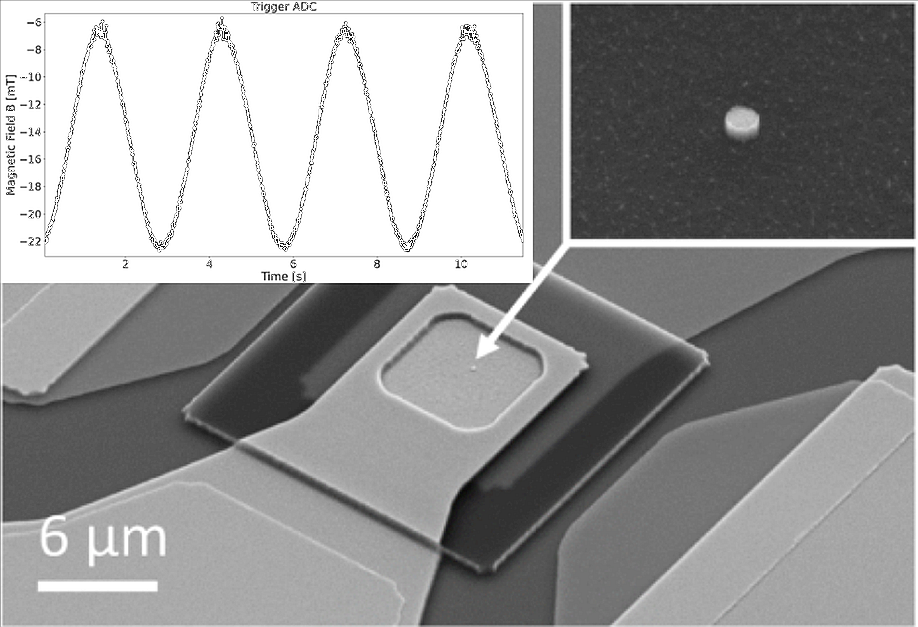A new type of magnetic sensor based on the spin transfer torque using 50-100nm diameter perpendicular magnetic tunnel junctions was recently reported in the IEEE Sensors Journal. The paper demonstrates the magnetic field sensing principle, patented by Spintec in 2020, while also describing possible read-out methods and their associated signal conditioning electronics. Improvements over conventional magneto-resistive (MR) sensors are the wide magnetic field range with a signal detection independent of the range.

Perpendicular magnetic tunnel junction fabricated to 50nm diameter. Detected signal from magnetic field applied with 10Hz.
A joint collaboration with the University of Applied Sciences Northwestern Switzerland and the University of Strasbourg allowed for this demonstration of a spin transfer toque (STT) based sensor application. Conventional MR sensors detection principle consists of a tradeoff between signal amplitude and magnetic field range, i.e. high sensitivity sensors have a limited field range. The sensitivity is defined as the resistance change per unit of magnetic field, and the sensor range represents the region where linearity between field and resistance change can be maintained. The demonstrated spin transfer torque provides new detection principle, no longer limited by the accuracy of the resistance measurement. The resistance is measured to detect changes between the junction low and high resistance states, when subjected to a periodic sine or triangular applied voltage. The voltage at which the junction switches state is linearly dependent on the applied field.
Magnetic field detection was proven, by detecting the sensor switching voltage with two possible schemes, time to digital converter or pulse width modulation (PWM). The PWM method achieved lower noise and better resolution, while requiring a larger layout for the associated electronic circuit. The main advantages of the proposed sensor are the small size of the sensor itself, resulting in low power and smaller footprint of the conditioning electronics. The detection range can be wider that MR sensors, as directivity is no longer linked and limited by the field range. The sensor is also immune to the application of large fields causing irreversible damage to MR sensors. Since the sensor is closely related to STT magnetic memory (MRAM) cells, monolithic sensor integration with CMOS circuits and mass production can be realized in MRAM foundries with minimal changes. Present sensor performance is still not at the level of commercially available MR sensors, but simple improvements of the sensing element as well as conditioning electronics are being implemented to lower the noise level. The sensor could find applications in diverse domains from industrial applications to the medical field, embedded either in a single small chip or as an array of sensing units.
Team: MRAM
Collaboration: University of Applied Sciences & Arts Northwestern Switzerland (Muttenz), ICube (University of Strasbourg)
Funding: Swiss Nanoscience Institute (No. A16.10), ERC-2020-PoC (MAGALIGN No. 963895)
Further reading: Conditioning Circuits for Nanoscale Perpendicular Spin Transfer Torque Magnetic Tunnel Junctions as Magnetic Sensors, H. Nicolas, R. C. Sousa, A. Mora-Hernández, I.-L. Prejbeanu, L. Hebrard, J.-B. Kammerer and J. Pascal, IEEE Sensors Journal 23, 5670 (2023), hal-04029607
Contact at Spintec: Ricardo SOUSA




